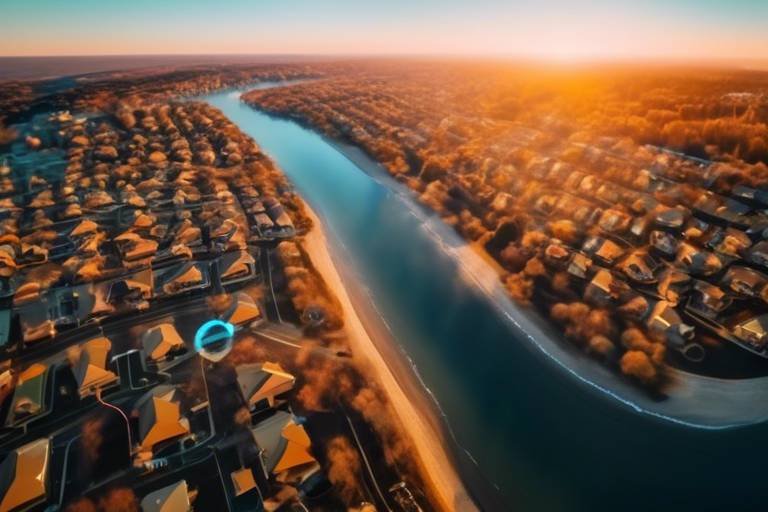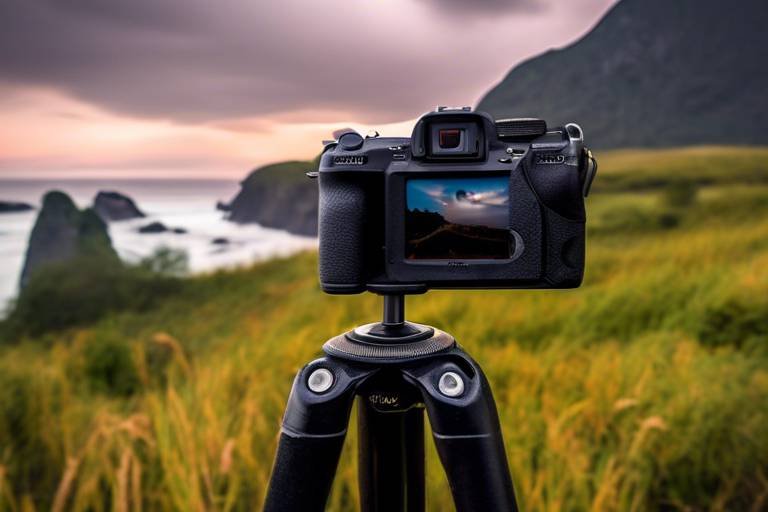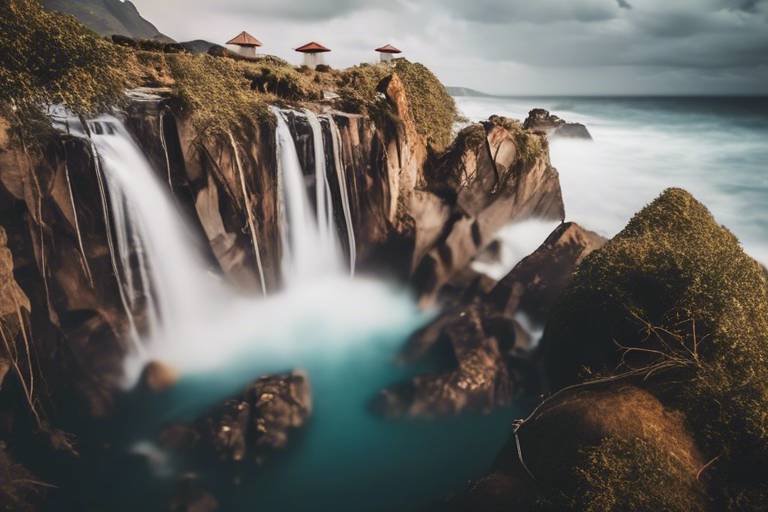How to Use Leading Lines to Enhance Your Travel Photos
Have you ever wondered how some travel photos seem to effortlessly draw you into the scene, making you feel like you're right there in the moment? The secret lies in the clever use of leading lines. These lines are like invisible pathways that guide the viewer's eyes towards the main subject of the photo, creating a sense of depth and visual interest.

Understanding Leading Lines
Learn how incorporating leading lines in your travel photography can create visually engaging images that draw viewers into the scene, guiding their eyes towards the main subject and adding depth to your photos.
Understanding leading lines in photography is crucial for creating compelling and visually appealing images. Leading lines are elements within a photo that guide the viewer's eye towards the main subject or focal point. They act as visual cues that help direct attention and create a sense of depth and movement in the composition. By strategically incorporating leading lines in your travel photos, you can enhance the overall impact and storytelling of your images.

Finding Leading Lines in Your Environment
Learn how incorporating leading lines in your travel photography can create visually engaging images that draw viewers into the scene, guiding their eyes towards the main subject and adding depth to your photos.
Explore the concept of leading lines in photography and how they can be utilized to direct the viewer's gaze towards the focal point of your image, enhancing composition and visual impact.
When it comes to finding leading lines in your environment, it's all about observing your surroundings with a creative eye. Look for natural elements like winding rivers that lead the viewer's gaze towards the horizon or man-made structures such as fences that guide the eye towards a distant mountain peak. By identifying these elements, you can add visual interest and depth to your travel photos, making them more captivating and dynamic.
In the world of photography, leading lines come in various forms, each offering a unique visual appeal. Whether it's the strong horizontal lines of a city skyline, the elegant curves of a winding road, or the converging lines of a railway track, understanding the different types of leading lines can help you create compelling compositions that capture the essence of your travel experiences.
Changing your perspective and shooting angles can completely transform the way leading lines interact with your composition. By getting low to the ground or shooting from a higher vantage point, you can play with the way lines converge or diverge, creating dynamic and visually striking images that tell a story and evoke emotions.
By incorporating leading lines into your travel photos, you can add a sense of depth and dimension that transports viewers into the heart of the scene. Whether it's a winding staircase leading towards a majestic castle or a row of palm trees guiding the eye towards a pristine beach, leading lines help create a visual journey that sparks the imagination and stirs the soul.
Balancing your composition with leading lines is like orchestrating a symphony of visual elements that harmonize to create a masterpiece. By strategically placing leading lines throughout your frame, you can guide the viewer's eye through the image, ensuring a balanced and aesthetically pleasing composition that captivates and delights.
After capturing your travel photos, the magic continues in the post-processing stage. Through techniques like cropping to emphasize leading lines, enhancing contrast to make them pop, and adjusting saturation to enhance their vibrancy, you can elevate your images to new heights, ensuring that your leading lines shine bright and true.
Immerse yourself in a world of inspiration with stunning examples of leading lines in travel photography. From the majestic leading lines of the Golden Gate Bridge to the serene curves of the Great Wall of China, these images showcase the power of leading lines in creating unforgettable and impactful travel photos.

Utilizing Different Types of Leading Lines
When it comes to photography, utilizing different types of leading lines can significantly enhance the visual impact of your travel photos. Each type of leading line, whether horizontal, vertical, diagonal, curved, or converging, offers a unique way to guide the viewer's eye through the image and create a sense of depth and movement.
Horizontal lines, such as the horizon or a straight road, can convey a sense of stability and tranquility in your photos. They are great for creating a sense of calm and balance in your composition, especially in landscapes or seascapes where the horizon line plays a crucial role.
Vertical lines, like tall buildings or trees, can add a sense of height and strength to your images. They often convey a feeling of grandeur and can be used to emphasize the scale of the subject or create a powerful visual impact.
Diagonal lines introduce a sense of dynamic movement and energy to your photos. They can create a sense of action or lead the viewer's eye towards a specific focal point, adding excitement and drama to your composition.
Curved lines, such as winding roads or rivers, offer a sense of flow and grace to your images. They can lead the viewer through the scene in a smooth and natural way, adding a sense of elegance and beauty to your travel photos.
Converging lines, like railway tracks or a row of trees, can create a sense of perspective and depth in your photos. They draw the viewer's eye towards a vanishing point, adding a three-dimensional quality to your composition and making the image more engaging and immersive.

Experimenting with Perspective and Angles
When it comes to creating captivating travel photos, experimenting with perspective and angles can truly elevate your photography game. By changing your viewpoint and shooting angles, you have the power to transform the way leading lines interact with your composition, resulting in dynamic and visually engaging images that stand out.
Imagine standing at the edge of a cliff, looking down at a winding river below. By adjusting your position slightly to the left or right, you can make the river appear as a leading line that guides the viewer's eye through the entire photograph, leading them towards the majestic mountains in the distance. This shift in perspective adds a sense of depth and drama to your image, making it more compelling and immersive.
Angles play a crucial role in photography, influencing how leading lines converge or diverge within your frame. Shooting from a low angle can make vertical lines appear taller and more imposing, while a high angle can accentuate diagonal lines, creating a sense of movement and energy in your composition.
Experimenting with perspective and angles allows you to play with the visual dynamics of leading lines, giving you the freedom to craft unique and impactful travel photos that leave a lasting impression on viewers. So, next time you're out exploring a new destination, don't be afraid to get creative with your shooting angles and discover the magic of leading lines in your photography.

Enhancing Depth and Dimension
When it comes to capturing stunning travel photos that truly transport viewers to the scene, incorporating leading lines can significantly enhance the depth and dimension of your images. By strategically using leading lines in your composition, you can create a sense of scale and perspective that draws viewers into the photograph, evoking a stronger emotional response.
Imagine standing at the edge of a winding road that disappears into the horizon, or gazing up at towering skyscrapers that seem to converge towards the sky. These are perfect examples of how leading lines can enhance the depth of your travel photos, adding layers of visual interest that invite the viewer to explore the scene further.
By utilizing natural elements like rivers, mountains, or tree branches as leading lines in your composition, you can create a sense of depth that immerses viewers in the environment. These lines not only guide the eye through the image but also provide a visual journey that enhances the overall storytelling of your photograph.
Experimenting with different angles and perspectives can further enhance the depth and dimension of your travel photos. By getting low to the ground or shooting from a high vantage point, you can play with how leading lines interact with the rest of your composition, creating dynamic visuals that captivate the viewer's attention.
Consider the architectural marvel of a bridge stretching across a river, with its lines leading towards a distant cityscape. By framing your shot to emphasize these leading lines, you can create a sense of distance and scale that adds a three-dimensional quality to your travel photos, making them more engaging and immersive.
Ultimately, by mastering the art of incorporating leading lines into your travel photography, you can elevate your images to new heights, transforming simple scenes into captivating visual stories that resonate with viewers on a deeper level.

Using Leading Lines for Composition Balance
Learn how incorporating leading lines in your travel photography can create visually engaging images that draw viewers into the scene, guiding their eyes towards the main subject and adding depth to your photos.
When it comes to creating a well-balanced composition in your travel photos, leading lines play a crucial role. These lines can not only guide the viewer's eye through the image but also help maintain harmony and visual interest.
Imagine your photo as a delicate scale, with leading lines acting as the counterweights that keep everything in perfect balance. By strategically placing these lines within your frame, you can ensure that every element has its place and purpose, creating a cohesive and visually appealing composition.
Think of leading lines as the invisible hands that gently lead the viewer on a journey through your photograph, ensuring that every detail is appreciated and every corner explored. When used effectively, these lines can transform a simple image into a captivating visual story, drawing the audience in and holding their attention.
Experiment with different types of leading lines, from straight and rigid to curved and flowing, to find the perfect balance for your composition. Consider how these lines interact with the other elements in your photo, guiding the viewer's gaze while maintaining a sense of equilibrium.
Remember, balance is not just about symmetry and stability; it's also about creating a sense of dynamic tension that keeps the viewer engaged. Leading lines can help you achieve this delicate balance, adding depth and dimension to your travel photos while ensuring that every aspect of the image works together harmoniously.
Q: How can I identify leading lines in a travel setting?
A: Look for natural elements like roads, rivers, or trees that create a path for the eye to follow. Man-made structures such as fences, bridges, or buildings can also serve as leading lines.
Q: Can leading lines work in any type of photography?
A: Yes, leading lines are a versatile compositional tool that can enhance various genres of photography, not just limited to travel photography.
Q: Is it necessary to use leading lines in every photo?
A: While leading lines can significantly improve the composition of your photos, it's not mandatory to include them in every shot. Experiment with different techniques to find what works best for each specific scene.

Post-Processing Techniques for Enhancing Leading Lines
Post-processing techniques play a crucial role in enhancing leading lines in your travel photos. By utilizing various editing tools, you can further emphasize the impact of leading lines and elevate the overall quality of your images. One effective technique is cropping, which allows you to adjust the composition of your photo to highlight leading lines and create a more compelling visual narrative. Additionally, enhancing contrast can make leading lines stand out more prominently, adding depth and definition to your photos. Adjusting saturation levels can also help intensify the colors along the leading lines, making them more visually striking.

Inspiring Examples of Leading Lines in Travel Photography
When it comes to capturing captivating travel photos, incorporating leading lines can truly elevate the visual impact of your images. Leading lines are a powerful compositional tool that can guide the viewer's eye through a photograph, leading them towards the main subject while adding depth and interest to the scene.
One inspiring example of leading lines in travel photography is a winding road cutting through a lush forest. The curving path of the road acts as a strong leading line, drawing the viewer into the image and creating a sense of movement and exploration. This type of leading line not only adds visual interest but also conveys a narrative, inviting the viewer to imagine the journey ahead.
Another example is a series of converging lines created by tall buildings in a cityscape. These vertical lines converge towards a vanishing point, creating a sense of depth and perspective in the photograph. The lines not only lead the viewer's eye towards the skyline but also add a dynamic element to the composition, making the image visually engaging.
Imagine a photograph of a lone figure walking along a deserted beach, with the receding tide leaving a trail of footprints in the sand. The footprints act as subtle leading lines, guiding the viewer's gaze towards the person and creating a sense of connection with the scene. These organic leading lines add a personal touch to the image, evoking emotions and storytelling.
One more example is a row of colorful beach huts along the shoreline, each painted in vibrant hues. The horizontal lines created by the huts draw the viewer's eye from one end of the image to the other, adding a sense of balance and harmony to the composition. These leading lines not only enhance the visual appeal of the photograph but also create a sense of tranquility and charm.
By studying these inspiring examples of leading lines in travel photography, you can gain valuable insights into how to effectively use this technique in your own work. Experiment with different types of leading lines, explore various perspectives and angles, and unleash your creativity to capture stunning travel photos that truly stand out.
Frequently Asked Questions
- What are leading lines in photography?
Leading lines are visual elements in a photograph that guide the viewer's eye towards the main subject or focal point. They can be natural or man-made elements like roads, fences, rivers, or buildings that create a path through the image, adding depth and visual interest.
- How can leading lines enhance travel photos?
By incorporating leading lines in your travel photography, you can create visually engaging images that draw viewers into the scene, add depth to your photos, and guide the viewer's gaze towards the focal point, resulting in a more impactful composition.
- What types of leading lines can be used in photography?
There are various types of leading lines, including horizontal, vertical, diagonal, curved, and converging lines. Each type can create a unique visual effect in your photos and contribute to the overall composition and storytelling of the image.
- How can I identify leading lines in different travel settings?
To find leading lines in your environment, look for elements that naturally lead the viewer's eye towards a specific point in the scene. Pay attention to shapes, patterns, and structures that can be used to create a visual path through your photograph.
- What post-processing techniques can be used to enhance leading lines?
Post-processing techniques such as cropping, adjusting contrast, and saturation can help emphasize leading lines in your travel photos. By fine-tuning these elements, you can further enhance the impact of your composition and draw attention to the guiding lines.
- Why is it important to experiment with perspective and angles when using leading lines?
Changing your perspective and shooting angles can alter how leading lines interact with your composition, allowing you to create dynamic and engaging travel photographs. By exploring different viewpoints, you can find unique ways to incorporate leading lines for visual impact.


















